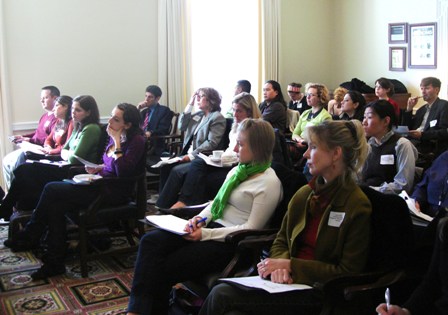We have much more to do and your continued support is needed now more than ever.
Schools Raise Staff’s Energy IQ
By Maryruth Belsey Priebe

“For 30 years, the university covered all of the energy costs at the system level,” explains Terry Ruprecht, Director of Energy Services for the University of Illinois (UI). “It meant that no one thought about energy or how it was used because no one paid a bill. The whole energy thing was out of sight, out of mind.”
A culmination of several factors, including spiralling energy costs, left UI staring down the barrel of a $100+ million deficit from utility accounts, resulting in job losses and a new interest in energy efficiencies. “What we had to do was figure out how to take campuses full of people who hadn’t thought about energy for 30 years and start to get them to think about it, and then get them to start using less.”
An energy awareness program was in order, and to get the word out, UI would rely on their new Energy Liaisons. Each college and/or department was responsible to name someone in their unit to function in this role. The response was tremendous, much to the surprise of organizers like Ruphrecht: “We were hoping to get about 50-60 people and ended with 137.”
An extensive metering and reporting system was also put in place to track and measure the energy used by individual buildings and departments.
Energy Liaisons were all brought together in formal orientation sessions where they were given some basic information about the program as well as ideas for how to get started. They were encouraged to be creative and to devise ways of saving energy that would suit the needs of their particular unit. Many formed committees, some of which invited Energy Services staff to give them additional training.
The liaisons were then supported with a number of different resources, including an Energy Conservation Toolkit, a regular newsletter, ideas for how to set goals, posters they could use to increase awareness, and a Liaison discussion board where people could get answers and share ideas (unfortunately, this last has fallen into disuse given that staff cuts have resulted in long response times for liaison questions).
One particularly active unit has been the Krannert Center for the Performing Arts, the audience of which is even wider than faculty, staff, and students. “We view the arts as an effective medium for societal issues, and I’ve had a long-time passion for the environment, so that put me in a great position.” That’s Rebecca McBride, the Senior Associate Director at the Center.

They key to their success, according to McBride, has been their ability to create a culture of environmental awareness rather than any formal programs. “We keep it in front of people all of the time.”
Ruprecht: “The biggest success has been that the liaison program put folks in side-by-side departments and buildings in touch with one another, creating an interest group that could then trade and share information. Once they could identify each other, we didn’t have to pump out the information. They were sharing among themselves.”
New York University (NYU) created a similar Sustainability Advocate Program to help NYU staff green their departments. The advocates also help to identify issues and opportunities for improvement at the ground level. Like UI, the NYU sustainability advocate program has seen surprising growth. They started with between 45 and 50 people, a number which has now more than doubled.
The program provides formal training for each advocate (both when they start and throughout the year) as well as a set of resources, including an office power savings checklist, energy presentations they can share with their colleagues, and talking points for how to encourage the use of recycled paper and toner.
Each advocate is allotted one to three hours of their paid work time each month to use for educating their fellow staff and faculty about how to save energy and implement more sustainable practices. And if a non-advocate wishes to seek out ideas for how to go green, they can access the Sustainability Advocate Map which pinpoints all campus advocates and where they’re located.
Because it is impossible to isolate the effect that these awareness and training programs have in terms of energy savings, it is hard to determine their effectiveness. How to engage staff and faculty in energy-saving efforts is also up for debate. While Ruprecht feels that the stick works best (“If someone else is paying the bills, they won’t care. The administrative and academic units have to have skin in the game.”), McBride would say that an attractive green culture in which people are empowered to implement ideas can’t help but lead to positive, energy-conscious patterns of behavior.
Either way, the enthusiasm is noteworthy: The hope is that creativity and excitement will lead to real, solid environmental gains.





















